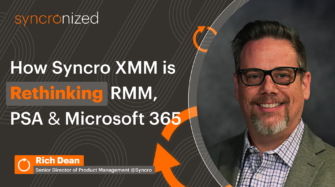MSP backup solutions are essential to any MSP’s backup and disaster recovery (BDR) strategy. Without backups, your clients are at a higher risk of data loss. And, without a reliable backup solution, MSPs might not be able to restore data effectively when the time comes.
In this article, we’ll take a deep dive into the different types of MSP backup solutions and how they can help you offer more robust and reliable services to your clients.
So, what exactly is an MSP backup solution?
An MSP backup solution is a software platform — typically a software platform targeted to MSPs and IT departments — that enables the creation and management of data backups and restoration from said backups.
Backup solutions for MSPs come in different flavors and can support your business model differently. For example, backup as a service (BaaS) uses a cloud model to provide users with backup storage and functionality. As an MSP, you can integrate a BaaS platform directly into your offering or generate revenue by reselling subscriptions to the platform.
On-premise backup solutions for MSPs provide similar functionality but don’t depend on the cloud.
Popular examples of backup solutions for MSPs include:
Acronis
Acronis offers several backup solutions including an Acronis Cyber Protect Cloud service where MSPs can create and manage different customers in a single account.

Comet
Comet is a popular backup platform that supports white labeling and a variety of different backup types.

Veeam
Veeam is one of the biggest players in the backup and disaster recovery space and offers MSP backup solutions such as their Service Provider Console.

What are the benefits of MSP backup solutions?
Like most else an MSP does, picking an MSP backup solution is a business decision. You should weigh the cost of the solution (in dollars and effort) against the benefits. To help you do just that, let’s take a look at four key MSP backup solution benefits:
- Increased resilience and security posture. Threats like ransomware and even simple human error or hardware failures regularly impact data at businesses of all sizes. Case in point: according to a recent report, 82% of ransomware attacks target small businesses. Reliable backups help limit the business impact of an incident that compromises data.
- Streamlined operations. Maintaining backups can be challenging for a single organization. It gets even more complex for an MSP that has to securely backup data from multiple organizations while maintaining isolation between different customers. A purpose-built backup solution can streamline the process, saving you time and money.
- More robust service offering. MSPs that leverage a backup solution can add capabilities like BDR to their offering and generate additional revenue.
- Peace of mind for you and your clients. “One is none” when it comes to critical data. Backups help you and your clients have the peace of mind that their business doesn’t have a single point of failure for their data.
What are the 3 MSP backup methods?
| Backup Method | Content | Pros | Cons |
|---|---|---|---|
| Full | Complete data set. |
|
|
| Differential | Data changes since the last full backup. |
|
|
| Incremental | Data changes since the last incremental backup. |
|
|
From 3-2-1 backups vs. 4-3-2 backups to different storage media types, there is plenty of nuance when it comes to backup methods. To help you get familiar with the details, let’s look at the three main types of backups. A good backup strategy often combines these different methods to strike a balance that addresses specific recovery time objectives (RTOs), recovery point objectives (RPOs), and resource constraints.
Full backup
Full backups are complete copies of a dataset. For example, a full backup includes a system’s volumes, files, folder, and associated metadata. The core benefit of a full backup is that it is a single source that provides a complete restoration point. That makes restoring from a full backup relatively quick and easy since you only need a single backup for a full restore.
The downside of a full backup is that regularly creating and storing them can become resource-intensive. Creating a full backup typically takes significantly more time, bandwidth, and storage space than the other backup methods.
Differential backup
A differential backup includes all the content changed since the most recent full backup. Every differential backup contains all the changes since the last full backup. For example, if you create a full backup on June 1st, a differential backup taken on June 8th would include all the changes made over the last week. A differential backup taken on June 15th would include all the changes made over the last two weeks, regardless of the content in the June 8th backup.
To restore using a differential backup, you need the most recent full backup plus the most recent differential backup.
Incremental backup
Incremental backups are similar to differential backups, except they only include the content changed since the previous incremental backup. Using our previous example, suppose a full backup is taken on June 1st. Then, an incremental backup is taken on June 8th containing all the last week’s changes. A subsequent backup taken on June 15th would include only the content that changed between June 8th and June 15th.
A full system recovery would require the full backup, the June 8th incremental backup, and the June 15th incremental backup.
Cloud vs on-premise vs hybrid backup
In addition to the different backup methods, where MSPs store their backups matters. Cloud and on-prem each have tradeoffs MSPs need to consider, and getting a hybrid approach right requires calibrating your strategy to get the best of both worlds. Let’s compare the three options and their implications for MSPs.
| Backup Type | Pros | Cons | Typical use cases |
|---|---|---|---|
| Cloud |
|
|
|
| On-premise |
|
|
|
| Hybrid |
|
|
|
Cloud
Cloud backup services enable MSPs to store and manage their backups using public cloud infrastructure. One of the biggest benefits of cloud backups is that they decouple an MSP’s backups from their other infrastructure, which can make for a more robust disaster recovery and business continuity strategy. Additionally, cloud backups abstract away the complexity of maintaining storage and providing high availability.
However, storing your backups in the cloud comes with some important downsides to consider:
- Sending, storing, and downloading Terabytes of data from the cloud can be costly.
- Recovering from a cloud backup can be significantly slower than your backup on the same LAN. Your Internet connection also becomes a potential point of failure when creating and restoring backups.
- Cloud storage can have complications from a compliance and data governance perspective.
On-premise
On-premise backups involve saving your backups using on-premise storage media such as a storage-attached network (SAN). Storing data on on-premises gives MSPs more control over backups and can enable faster backup and recovery times.
However, on-premises storage is more difficult to scale and comes with additional operational overhead. This can create significant challenges for an MSP with multiple clients. You or your clients’ IT department will have to handle infrastructure maintenance and high availability instead of offloading the work to a cloud service.
Hybrid
Hybrid backups combine on-premises and cloud backups. As a result, a hybrid MSP backup solution provides MSPs with the most flexibility. You can leverage cloud backups where scalability and simplicity are needed and opt for on-premise solutions where you need more control or cloud backups aren’t cost-effective.
Of course, the tradeoff with a hybrid approach is complexity. MSPs can fine-tune their storage options to meet their needs, but using both on-premise and cloud solutions can lead to tool sprawl and operational complexity.
Five key considerations when choosing an MSP backup solution
Choosing between cloud, on-premise, and hybrid backup solutions involves analyzing multiple criteria. Here are five criteria to consider when making your choice:
- RTO and RPO. RTO tells you how long a system can be down while you recover from an incident. Your RTO can influence what cloud storage tiers you should use or on-premise storage media you should use. RPO tells you how much data loss is acceptable and will directly impact how frequently you have to back your systems up.
Pro tip: Begin your analysis with RTO and RPO. Knowing how long recovery can take and how much data loss is acceptable will enable you to properly frame the other criteria. - Data volume. How much data you need to store will be one of your biggest cost drivers. The more data you have, the more you’ll have to invest in cloud storage on on-premise hardware. Choosing the right combination of full, incremental, and differential backups can help you optimize costs while meeting business requirements. Make sure to consider your data retention requirements when analyzing your data volume.
- Internet connectivity and bandwidth. A location with reliable, high-throughput Internet connectivity might be ideal for cloud backups. One with intermittent or poor Internet connectivity will likely struggle to reliably backup — or restore — from the cloud.
- Testing plan. Not testing backups is one of the biggest — and most avoidable — mistakes in IT. As a trusted advisor for your clients, you’ll want to recommend regular testing backups and recovery. Both on-premise and cloud solutions will require some time and effort to test, and cloud platforms may come with additional data egress costs.
- Data security and compliance requirements. Data security and compliance requirements may disqualify some cloud storage options. For example, the EU’s General Data Protection Regulation (GDPR) has strict data residency requirements that may dictate where data can be stored.
Protect your business with Syncro
Syncro, the all-in-one integrated MSP platform, is dedicated to helping MSPs run a more profitable business, and our partnership with Acronis is a great way for MSPs to leverage powerful MSP backup solutions at an affordable price. Syncro partners in the US, Canada, New Zealand, Australia, UK, and EU can access the Acronis Cyber Protect products with a no-commitment, no-minimum pricing model that includes automatic discounts.
Together, Syncro and Acrois solutions help MSPs streamline their operations, delight their clients, and protect their business. To see what the Syncro platform can do for you, sign up for a free trial today!
Share














